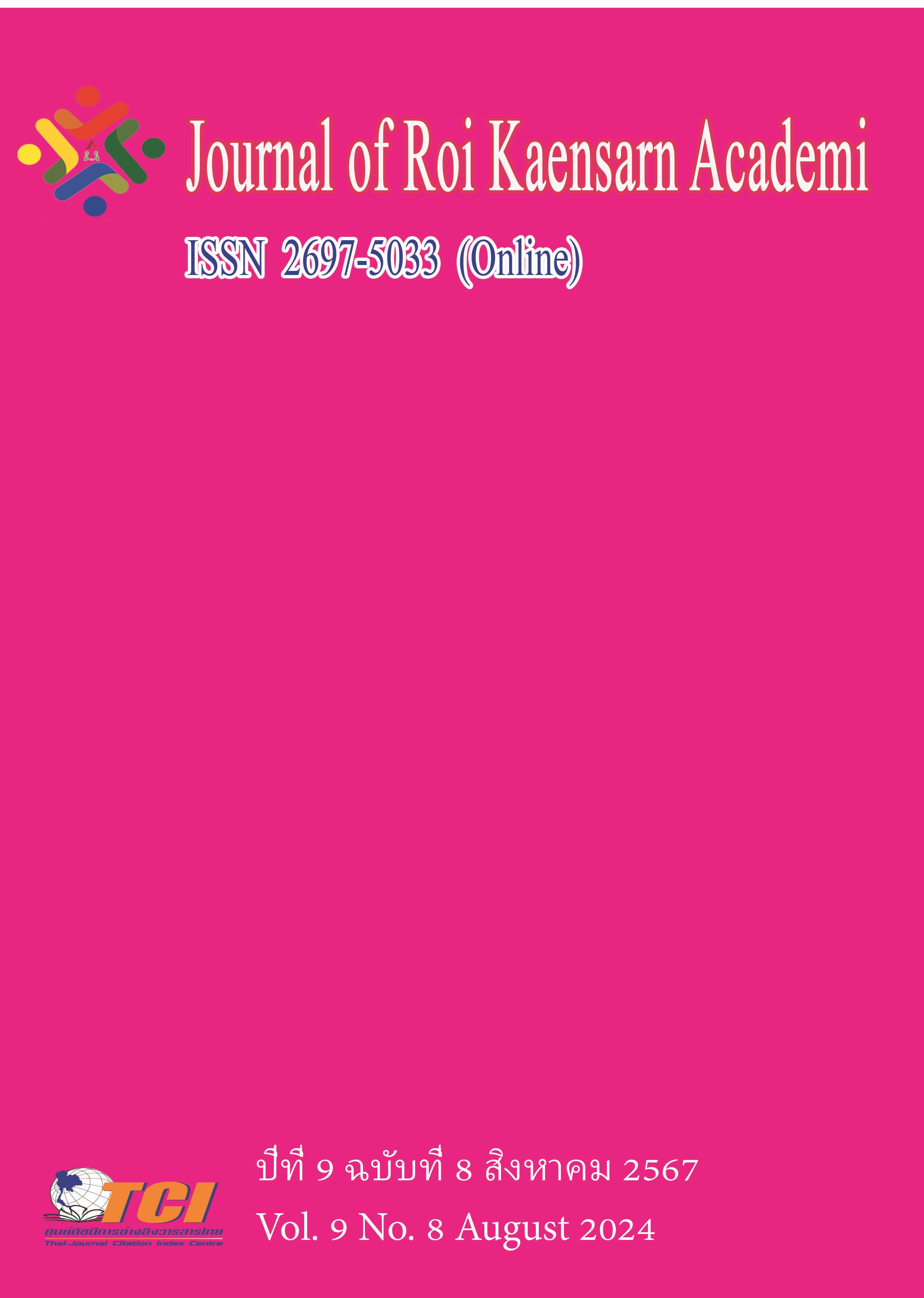Ancient Intangible Cultural Heritage Assets and Inventive Materials for Making Paper-Cutting Arts at Zhangpu’s Communities, Fujian Province of the PRC
Main Article Content
บทคัดย่อ
Article Details
References
AFS-USA Intercultural Programs. (2015). China: Exploring Chinese customs and culture. Online. Retrieved February, 5 2024. From: https://www.afsusa.org/countries/china/
Cui, B. L. (2024). The material development for creative paper-cutting art from Zhangpu Community Capital. Doctoral Thesis, Faculty of Fine and Applied Arts Research and Creation, Mahasarakham University, Thailand.
Fisher, D., Rickards, T., & Fraser, B. (1999). Assessing teacher-student interpersonal relationships in science classes. Australian Science Teachers Journal. 42, 28-33.
Fraser, B., McRobbie, C. J., & Giddings, G. J. (1993). Development and cross-national validation of a laboratory classroom instrument for senior high school students. Science Education. 77, 1-24.
Hemara, C., Ketkan, P., Singchainara, J., & Santiboon, T. T. (2021). Efficient archery posture training analysis of archery performances for the talent development and excellence achievements. International Journal of Human Movement and Sports Sciences. 9 (6), 1435 – 1446. DOI: 10.13189/saj.2021.090640
Hiziroglu, S. (2016). Basics of paper manufacturing. Oklahoma State University. Published Jul. 2016.https://extension.okstate.edu/fact-sheets/basics-of-paper-manufacturing.html
Huang, H. (2009). Fujian Tulou: A jewel of China's traditional residential architecture. Sanlian Books: 154–157. ISBN 978-7-108-03175-4
Huang, H. (2009). Fujian Tulou: A jewel of China's traditional residential architecture. Sanlian Books: 218–219. ISBN 978-7-108-03175-4
Katasila, S., & Santiboon, T. T. (2023). The great mass spectacular on citizenry recognition for participating in changes into the PDRC group in the 2013-2014 Thai political protest crisis. Journal of Namibian Studies, 33. DOI: https://doi.org/10.59670/jns.v33i. 4434
Khuana, K., Khuana, T., & Santiboon, T. T. (2017). An instructional design model with the cultivating research-based learning strategies for fostering teacher students' creative thinking abilities. Educational Research and Reviews. 12 (15), 712-724. DOI:10. 5897/ERR2017.3239
Lin, S. Y. (2016). The evolution and development of Zhangpu paper cutting art in the modern aesthetic perspective. The 2nd Annual International Conference on Social Science and Contemporary Humanity Development, January 2016. DOI:10.2991/sschd-16.2016.19.
Lin, X. (2023). The patterns of life. China Daily. Online. Retrieved January, 31, 2023. From:https://www.chinadaily.com.cn/a/202301/31/WS63d85a3da31057c47ebabef8_2.html
Longhua Government Online. (2023). Traditional arts thrive in the modern era. Shenzhen Daily. Online. Retrieved June 14, 2023. https://www.szlhq.gov.cn/english/Inter nationalBlocksinLonghua/GuanlanInternationalBlock/ content/post_10647816.html
McCracken-Barber, S. (2013). Paper-cutting art & history. Plymouth State University Press: 32-40.
Prakongsri, P., & Santiboon, T. T. (2020). Effective water resources management for communities in the Chi River Basin in Thailand. Environmental Claims Journal. 32 (1), 1-26. DOI:10.1080/10406026.2020.1765529
Qian, B., & Yang, Y. (2022). Research on the innovation of paper-cutting art. Frontiers in Art Research. 4 (8), 51-54. DOI: 10.25236/FAR.2022.040811. Published by Francis Academic Press, UK.
Quek, C. L., Wong, A. F. & Fraser, B. L. (2002). Gender differences in the perceptions of chemistry laboratory classroom environments. Queendlands Journal Education Research. 18, 23 - 32.
Read, S. J. (2022). Beginner's guide to paper-cutting. Gathered, Our Media Ltd., https://www.gathered.how/papercraft/beginners-guide-to-paper-cutting.
Santiboon, T. (2011). My school and my dream school climate. Proceeding at the 4th International Conference on Educational Reform 2011 (ICER 2011) ‘Equity in Education’. Luang Prabang. Loas PDR.
Santiboon, T. (2012). Santiboon, T. (2012). Effects of global warming on climate change in Udon Thani province in the period of 60 surrounding years (A.D.1951-2010). IOSR Journal of Engineering (IOSRJEN). 4 (1), 71 – 82.
Santiboon, T. (2015). Global warming and climate change in Thailand. American Journal of Climate Change. 7 (1), 30 - 41. The Best Research Entitled of the World in 2015.
Santiboon, T. (2017). Appropriating characteristics of the 21st century teachers to transform the Thailand 4.0 policies. African Journal of Pedagogy and Curriculum. 4 (1), 48-64
Shanghai People's Association for Friendship with Foreign Countries. (2017). Paper-cut art: from ancient times to modern technology. Shanghai Daily. Retrieved September 24, 2017. https://www.shine.cn/feature/art-culture/1709193904/
Sullivan, M., & Murphy, F. D. (1996). Art and artists of twentieth-century China. University of California Press:150.
Tasillo, M. (2021). Selecting source fibers. Hand Papermaking Publication, Inc. online. Retrieved March 16, 2021. https://www.handpapermaking.org/post/selecting-source-fibers
UNESCO. (2007). Culture: Protecting our heritage and fostering creativity. UNESCO Organization. Online. Retrieved June 20, 2007. https://www.unesco.org/en/culture #meet_00057
UNESCO Intangible Cultural Heritage. (2009). Chinese paper-cut: Inscribed in 2009 (4.COM) on the representative list of the intangible cultural heritage of humanity.
University of Hawaiʻi at Mānoa Library. (2009). Chinese paper cut. Asia Collection. Online. Retrieved February 28, 2009. https://manoa.hawaii.edu/library/about/news-events/ exhibits/chinese-paper-cut/
Weizi, B. (2021). One of the Four Great Inventions of China: Paper-making. Science and Technology Daily. Online. Retrieved December 21, 2016. http://www.stdaily.com/ English/Service/2021-12/16/content_1239506.shtml
Yarrow, A. Millwater, J., & Fraser, B. (1997). Improving university and primary school classroom environments through preservice teachers’ action research. International Journal of Practical Experiences in Professional Education. 1 (1), 68-93.
